Cargando...
Recursos educativos
-
Nivel educativo
-
Competencias
-
Tipología
-
Idioma
-
Tipo de medio
-
Tipo de actividad
-
Destinatarios
-
Tipo de audiencia
-
Creador
Lo más buscado
-

Introduction - Migration
EduBook Organización
- 3408 visitas
The ever-changing nature of the world's population is affected by factors such as the birth rate, mortality rate and, above all, migration (the movement of people from one place to another). Today,…
-

Final self-evaluation 12.06 - The Population of Spain
EduBook Organización
- 3193 visitas
Match each statement with the correct theme: Another group of immigrants is made up of refugees and asylum seekers. Agricultural and mountain areas in the interior of Spain have been losing population.…
-

Introduction - The Population of Spain
EduBook Organización
- 2988 visitas
Spain is not densely populated compared to other European countries. However, in the 20th century the population began to grow. The major changes in Spain's population in recent decades have been…
-

Asturian workers' demands
EduBook Organización
- 2950 visitas
Wage increases (…). Six-hour shifts for workers during the day and at night (…). Equal wages for equal jobs. Two months of paid holiday per year. The payment of 75 % of wages to unemployed workers…
-

Estates of the realm and absolute monarchy
EduBook Organización
- 1 lo usan
- 2634 visitas
2.1. Inequality Society under the Ancien Régime was divided into groups, or the so-called estates of the realm: the privileged (First and Second Estate) and the unprivileged (Third Estate). It was…
-

Identify. Elements of inequality
EduBook Organización
- 2711 visitas
Match the following definitions with a concept of inequality: Exchange in which the producer receives a suitable price for his or her products. The result of a high birth rate and a decreasing mortality…
-

End-of-unit evaluation - The Population of Spain
EduBook Organización
- 2723 visitas
Spain is not densely populated compared to other European countries. However, in the 20th century the population began to grow. The major changes in Spain's population in recent decades have been…
-

End-of-unit activities - The Population of Spain
EduBook Organización
- 2709 visitas
Spain is not densely populated compared to other European countries. However, in the 20th century the population began to grow. The major changes in Spain's population in recent decades have been…
-

Population and agriculture in the 19th century
EduBook Organización
- 2673 visitas
1.1. Population growth Spain's population grew from 11.5 million in 1797 to 18.6 million in 1900, an increase of 60 %. The birth rate remained stable. Although mortality rates fell, famines…
-

Te estamos redirigiendo a la ficha del libro...













